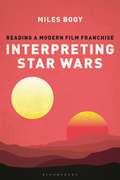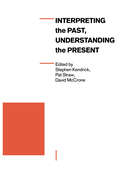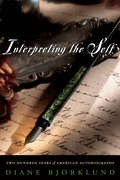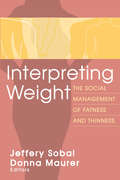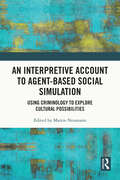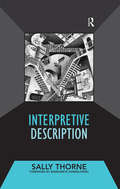- Table View
- List View
Interpreting Social and Behavioral Research: A Guide and Workbook Based on Excerpts from Journals
by Linda E DorstenFirst published in 1996. This book is designed to help students acquire basic skills needed to comprehend social and behavioural science research reports. These skills are needed to understand research results that we confront in our everyday lives in magazines, newspapers, on television, and elsewhere. It includes a guide and a workbook.
Interpreting Star Wars: Reading a Modern Film Franchise
by Miles BooyUpon its initial release in 1977, many critics regarded Star Wars as a childish retort to the mature American cinema of the seventies. Though full of sound and fury, some felt that it signified nothing. Four decades later, the significations are multiple as interpretations of the film's strange imagery and metaphoric potential continue to pile up. Interpreting Star Wars analyses and contextualises the dominant trends in Star Wars interpretation from the earliest reviews, through Lucasfilm's attempts to use its position as copyright holder to promote a single meaning, to the 21st century where the internet has rendered such authorial control impossible and new entries to the canon present new twists on old hopes.
Interpreting Star Wars: Reading a Modern Film Franchise
by Miles BooyUpon its initial release in 1977, many critics regarded Star Wars as a childish retort to the mature American cinema of the seventies. Though full of sound and fury, some felt that it signified nothing. Four decades later, the significations are multiple as interpretations of the film's strange imagery and metaphoric potential continue to pile up. Interpreting Star Wars analyses and contextualises the dominant trends in Star Wars interpretation from the earliest reviews, through Lucasfilm's attempts to use its position as copyright holder to promote a single meaning, to the 21st century where the internet has rendered such authorial control impossible and new entries to the canon present new twists on old hopes.
Interpreting the Chinese Diaspora: Identity, Socialisation, and Resilience According to Pierre Bourdieu (Routledge Studies on Asia in the World)
by Guanglun Michael Mu Bonnie PangGlobalisation and migration have created a vibrant yet dysphoric world fraught with different, and sometimes competing, practices and discourses. The emergent properties of the modern world inevitably complicate the being, doing, and thinking of Chinese diasporic populations living in predominantly white, English-speaking societies. This raises questions of what 'Chineseness' is. The gradual transfer of power from the West to the East shuffles the relative cultural weights within these societies. How do the global power shifts and local cultural vibrancies come to shape the social dispositions and positions of the Chinese diaspora, and how does the Chinese diaspora respond to these changes? How does primary pedagogic work through family upbringing and secondary pedagogic work through educational socialisation complicate, obfuscate, and enrich Chineseness? Drawing on Pierre Bourdieu’s reflexive sociology on relative and relational sociocultural positions, Mu and Pang assess how historical, contemporary, and ongoing changes across social spaces of family, school, and community come to shape the intergenerational educational, cultural, and social reproduction of Chinese diasporic populations. The two authors engage in an in-depth analysis of the identity work, educational socialisation, and resilience building of young Chinese Australians and Chinese Canadians in the ever-changing lived world. The authors look particularly at the tensions and dynamics around the participants’ life and educational choices; the meaning making out of their Chinese bodies in relation to gender, race, and language; and the sociological process of resilience that enculturates them into a system of dispositions and positions required to bounce back from structural constraints.
Interpreting the Chinese Diaspora: Identity, Socialisation, and Resilience According to Pierre Bourdieu (Routledge Studies on Asia in the World)
by Guanglun Michael Mu Bonnie PangGlobalisation and migration have created a vibrant yet dysphoric world fraught with different, and sometimes competing, practices and discourses. The emergent properties of the modern world inevitably complicate the being, doing, and thinking of Chinese diasporic populations living in predominantly white, English-speaking societies. This raises questions of what 'Chineseness' is. The gradual transfer of power from the West to the East shuffles the relative cultural weights within these societies. How do the global power shifts and local cultural vibrancies come to shape the social dispositions and positions of the Chinese diaspora, and how does the Chinese diaspora respond to these changes? How does primary pedagogic work through family upbringing and secondary pedagogic work through educational socialisation complicate, obfuscate, and enrich Chineseness? Drawing on Pierre Bourdieu’s reflexive sociology on relative and relational sociocultural positions, Mu and Pang assess how historical, contemporary, and ongoing changes across social spaces of family, school, and community come to shape the intergenerational educational, cultural, and social reproduction of Chinese diasporic populations. The two authors engage in an in-depth analysis of the identity work, educational socialisation, and resilience building of young Chinese Australians and Chinese Canadians in the ever-changing lived world. The authors look particularly at the tensions and dynamics around the participants’ life and educational choices; the meaning making out of their Chinese bodies in relation to gender, race, and language; and the sociological process of resilience that enculturates them into a system of dispositions and positions required to bounce back from structural constraints.
Interpreting the Early Modern World: Transatlantic Perspectives (Contributions To Global Historical Archaeology)
by Mary C. C. Beaudry and James SymondsThis volume is based on a session at a 2005 Society for Historical Archaeology meeting. The organizers assembled historical archaeologists from the UK and the US, whose work arises out of differing intellectual traditions. The authors exchange ideas about what their colleagues have written, and construct dialogues about theories and practices that inform interpretive archaeology on either side of the Atlantic, ending with commentary by two well-known names in interpretive archaeology.
Interpreting the Landscape: Landscape Archaeology and Local History
by Michael AstonMost places in Britain have had a local history written about them. Up until this century these histories have addressed more parochial issues, such as the life of the manor, rather than explaining the features and changes in the landscape in a factual manner. Much of what is visible today in Britain's landscape is the result of a chain of social and natural processes, and can be interpreted through fieldwork as well as from old maps and documents.Michael Aston uses a wide range of source material to study the complex and dynamic history of the countryside, illustrating his points with aerial photographs, maps, plans and charts. He shows how to understand the surviving remains as well as offering his own explanations for how our landscape has evolved.
Interpreting the Landscape: Landscape Archaeology and Local History
by Michael AstonMost places in Britain have had a local history written about them. Up until this century these histories have addressed more parochial issues, such as the life of the manor, rather than explaining the features and changes in the landscape in a factual manner. Much of what is visible today in Britain's landscape is the result of a chain of social and natural processes, and can be interpreted through fieldwork as well as from old maps and documents.Michael Aston uses a wide range of source material to study the complex and dynamic history of the countryside, illustrating his points with aerial photographs, maps, plans and charts. He shows how to understand the surviving remains as well as offering his own explanations for how our landscape has evolved.
Interpreting the Past, Understanding the Present (Explorations in Sociology.)
by Stephen Kendrick David McCrone Pat StrawThe British Sociological Association held a conference on the theme "Sociology and History". In 1964, E.H. Carr had called for an open frontier between the disciplines. This book examines the traffic across this frontier and in particular, what might be called the sociological uses of history.
Interpreting the Peace: Peace Operations, Conflict and Language in Bosnia-Herzegovina (Palgrave Studies in Languages at War)
by M. Kelly C. BakerAnalysing the issues of language that faced international forces carrying out peace operations in Bosnia-Herzegovina in the 1990s, this book examines how differences of language were an integral part of the conflicts in the country and in what way the multinational UN and NATO forces faced their own problems of communication and language support.
Interpreting the Self: Two Hundred Years of American Autobiography
by Diane BjorklundIn this ambitious study, Diane Bjorklund explores the historical nature of self-narrative. Examining over 100 American autobiographers published in the last two centuries, she discusses not only well-known autobiographies such as Mark Twain and Andrew Carnegie but also many obscure ones such as a traveling book peddler, a minstrel, a hotel proprietress, an itinerant preacher, a West Point cadet, and a hoopskirt wire manufacturer. Bjorklund draws on the colorful stories of these autobiographers to show how their historical epoch shapes their understandings of self. "A refreshingly welcome approach to this intriguing topic. . . . [Bjorklund's] extensive and systematic approach to her source material is impressive and enriches our understanding of this essential subject."—Virginia Quarterly Review "Bjorklund studies both famous and obscure writers, and her clear prose style and copious quotations provide insight into the many aspects of the changing American self." —Library Journal
Interpreting Tyler Perry: Perspectives on Race, Class, Gender, and Sexuality (Routledge Transformations in Race and Media)
by Jamel Santa Cruze Bell Ronald L. JacksonTyler Perry has become a significant figure in media due to his undeniable box office success led by his character Madea and popular TV sitcoms House of Payne and Meet the Browns. Perry built a multimedia empire based largely on his popularity among African American viewers and has become a prominent and dominant cultural storyteller. Along with Perry’s success has come scrutiny by some social critics and Hollywood well-knowns, like Spike Lee, who have started to deconstruct the images in Perry’s films and TV shows suggesting, as Lee did, that Perry has used his power to advance stereotypical depictions of African Americans. The book provides a rich and thorough overview of Tyler Perry’s media works. In so doing, contributors represent and approach their analyses of Perry’s work from a variety of theoretical and methodological angles. The main themes explored in the volume include the representation of (a) Black authenticity and cultural production, (b) class, religion, and spirituality, (c) gender and sexuality, and (d) Black love, romance, and family. Perry’s critical acclaim is also explored.
Interpreting Tyler Perry: Perspectives on Race, Class, Gender, and Sexuality (Routledge Transformations in Race and Media)
by Jamel Santa Cruze Bell Ronald L. JacksonTyler Perry has become a significant figure in media due to his undeniable box office success led by his character Madea and popular TV sitcoms House of Payne and Meet the Browns. Perry built a multimedia empire based largely on his popularity among African American viewers and has become a prominent and dominant cultural storyteller. Along with Perry’s success has come scrutiny by some social critics and Hollywood well-knowns, like Spike Lee, who have started to deconstruct the images in Perry’s films and TV shows suggesting, as Lee did, that Perry has used his power to advance stereotypical depictions of African Americans. The book provides a rich and thorough overview of Tyler Perry’s media works. In so doing, contributors represent and approach their analyses of Perry’s work from a variety of theoretical and methodological angles. The main themes explored in the volume include the representation of (a) Black authenticity and cultural production, (b) class, religion, and spirituality, (c) gender and sexuality, and (d) Black love, romance, and family. Perry’s critical acclaim is also explored.
Interpreting Visual Ethnography: Texts, Photos and the Construction of Sociological Meanings
by Erkan AliFocusing on the use of text in relation to a specific category of image - the photographic image - this book argues for a new appreciation of the relationship between texts and photographs in an age that seems to be dominated by visual images. With reference to a range of traditional and new media forms, and addressing such issues as gender, ethnicity, class, identity politics and biography, the author introduces a new perspective for the use and understanding of the symbiotic relationships that can exist between photographs and texts in the production of sociological, cultural and historical narratives: lamination. Drawing on the work of Barthes and Benjamin, the book explores the material forms of publications that involve the combination of photographs and texts, such as newspapers and journalism, documentary archives, visual ethnographies and on-line social networks, showing how text and image are contexts for one another and so negotiate meaning between themselves. A challenge to the recent 'visual turn' in sociology and cultural studies, which argues - without privileging text or image - for the significance of text in relation to visual images and the production of combined meanings, Interpreting Visual Ethnography will appeal to scholars of sociology, anthropology and media studies with interests in theory, visual methods and text and meaning.
Interpreting Visual Ethnography: Texts, Photos and the Construction of Sociological Meanings
by Erkan AliFocusing on the use of text in relation to a specific category of image - the photographic image - this book argues for a new appreciation of the relationship between texts and photographs in an age that seems to be dominated by visual images. With reference to a range of traditional and new media forms, and addressing such issues as gender, ethnicity, class, identity politics and biography, the author introduces a new perspective for the use and understanding of the symbiotic relationships that can exist between photographs and texts in the production of sociological, cultural and historical narratives: lamination. Drawing on the work of Barthes and Benjamin, the book explores the material forms of publications that involve the combination of photographs and texts, such as newspapers and journalism, documentary archives, visual ethnographies and on-line social networks, showing how text and image are contexts for one another and so negotiate meaning between themselves. A challenge to the recent 'visual turn' in sociology and cultural studies, which argues - without privileging text or image - for the significance of text in relation to visual images and the production of combined meanings, Interpreting Visual Ethnography will appeal to scholars of sociology, anthropology and media studies with interests in theory, visual methods and text and meaning.
Interpreting Weight: The Social Management of Fatness and Thinness
by Jeffery SobalWhat is "too fat"? what is "too thin"? Interpretations of body weight vary widely across and within cultures. Meeting weight expectations is a major concern for many people because failing to do so may incur dire social consequences, such as difficulty in finding a romantic partner or even in locating adequate employment. without these social and cultural pressures, body weight would only be a health issue. while socially constructed standards of body weight may seem immutable, they are continuously recreated through social interactions that perpetuate or transform expectations about fatness and thinness. Written by sociologists, psychologists, and nutritionists, all of the chapters in this book focus on how people construct fatness and thinness, examining different strategies used to interpret body weight, such as negotiating weight identities, reinterpreting weight, and becoming involved in weight-related organizations. Together these chapters emphasize the many ways that people actively define, construct, and enact their fatness and thinness in a variety of settings and situations.
Interpreting Weight: The Social Management of Fatness and Thinness (Social Problems And Social Issues Ser.)
by Jeffery SobalWhat is "too fat"? what is "too thin"? Interpretations of body weight vary widely across and within cultures. Meeting weight expectations is a major concern for many people because failing to do so may incur dire social consequences, such as difficulty in finding a romantic partner or even in locating adequate employment. without these social and cultural pressures, body weight would only be a health issue. while socially constructed standards of body weight may seem immutable, they are continuously recreated through social interactions that perpetuate or transform expectations about fatness and thinness. Written by sociologists, psychologists, and nutritionists, all of the chapters in this book focus on how people construct fatness and thinness, examining different strategies used to interpret body weight, such as negotiating weight identities, reinterpreting weight, and becoming involved in weight-related organizations. Together these chapters emphasize the many ways that people actively define, construct, and enact their fatness and thinness in a variety of settings and situations.
An Interpretive Account to Agent-based Social Simulation: Using Criminology to Explore Cultural Possibilities
by Martin NeumannUsing the investigation of criminal culture as an example application, this edited volume presents a novel approach to agent-based simulation: interpretive agent-based social simulation as a methodological and transdisciplinary approach to examining the potential of qualitative data and methods for agent-based modelling (ABM). Featuring updated articles as well as original chapters which provide a cohesive and novel approach to the digital humanities, the book challenges the common conviction that hermeneutics and simulation are two mutually exclusive ways to understand and explain human behaviour and social change. Exploring how methodology benefits from taking cultural complexities into account and bringing these methods together in an innovative combination of qualitative-hermeneutic and digital techniques, the book unites experts in the field to connect ABM to narrative theories, thereby providing a novel tool for cultural studies. An innovative methodological contribution to narrative theory, this volume will be of primary benefit to researchers, scholars, and academics in the fields of ABM, hermeneutics, and criminology. The book will also appeal to those working in policing, security, and forensic consultation.
An Interpretive Account to Agent-based Social Simulation: Using Criminology to Explore Cultural Possibilities
by Martin NeumannUsing the investigation of criminal culture as an example application, this edited volume presents a novel approach to agent-based simulation: interpretive agent-based social simulation as a methodological and transdisciplinary approach to examining the potential of qualitative data and methods for agent-based modelling (ABM). Featuring updated articles as well as original chapters which provide a cohesive and novel approach to the digital humanities, the book challenges the common conviction that hermeneutics and simulation are two mutually exclusive ways to understand and explain human behaviour and social change. Exploring how methodology benefits from taking cultural complexities into account and bringing these methods together in an innovative combination of qualitative-hermeneutic and digital techniques, the book unites experts in the field to connect ABM to narrative theories, thereby providing a novel tool for cultural studies. An innovative methodological contribution to narrative theory, this volume will be of primary benefit to researchers, scholars, and academics in the fields of ABM, hermeneutics, and criminology. The book will also appeal to those working in policing, security, and forensic consultation.
Interpretive Description
by Sally ThorneThis book is designed to guide both new and more seasoned researchers through the steps of conceiving, designing, and implementing coherent research capable of generating new insights in clinical settings. Drawing from a variety of theoretical, methodological, and substantive strands, interpretive description provides a bridge between objective neutrality and abject theorizing, producing results that are academically credible, imaginative, and clinically practical. Replete with examples from a host of research settings in health care and other arenas, the volume will be an ideal text for applied research programs.
Interpretive Description: Qualitative Research For Applied Practice (Developing Qualitative Inquiry Ser. #2)
by Sally ThorneThis book is designed to guide both new and more seasoned researchers through the steps of conceiving, designing, and implementing coherent research capable of generating new insights in clinical settings. Drawing from a variety of theoretical, methodological, and substantive strands, interpretive description provides a bridge between objective neutrality and abject theorizing, producing results that are academically credible, imaginative, and clinically practical. Replete with examples from a host of research settings in health care and other arenas, the volume will be an ideal text for applied research programs.
Interpretive Planning for Museums: Integrating Visitor Perspectives in Decision Making
by Marcella Wells Barbara H Butler Judith KokeMuseum professionals' increased focus on visitors in recent years has been demonstrated by, among other things, the enhanced practice of evaluation and the development of interpretive plans. Yet too often, these efforts function independent of one another. This book helps museums integrate visitors' perspectives into interpretive planning by recognizing, defining, and recording desired visitor outcomes throughout the process. The integration of visitor studies in the practice of interpretive planning is also based on the belief that the greater our understanding, tracking, and monitoring of learners, the greater the impact museums will make on public understanding of the science and humanities disciplines. An approach that advocates thoughtful and intentional interpretive planning that constantly integrates visitor perspectives is the next step in working with, rather than for, our communities; a step toward truly becoming visitor-centered and impactful as essential learning institutions of the 21st century.
Interpretive Planning for Museums: Integrating Visitor Perspectives in Decision Making
by Marcella Wells Barbara H Butler Judith KokeMuseum professionals' increased focus on visitors in recent years has been demonstrated by, among other things, the enhanced practice of evaluation and the development of interpretive plans. Yet too often, these efforts function independent of one another. This book helps museums integrate visitors' perspectives into interpretive planning by recognizing, defining, and recording desired visitor outcomes throughout the process. The integration of visitor studies in the practice of interpretive planning is also based on the belief that the greater our understanding, tracking, and monitoring of learners, the greater the impact museums will make on public understanding of the science and humanities disciplines. An approach that advocates thoughtful and intentional interpretive planning that constantly integrates visitor perspectives is the next step in working with, rather than for, our communities; a step toward truly becoming visitor-centered and impactful as essential learning institutions of the 21st century.
Interpretive Political Science: Selected Essays, Volume II
by R.A.W. RhodesInterpretive Political Science is the second of two volumes featuring a selection of key writings by R.A.W. Rhodes. Volume II looks forward and explores the 'interpretive turn' and its implications for the craft of political science, especially public administration, and draws together articles from 2005 onwards on the theme of 'the interpretive turn' in political science. Part I provides a summary statement of the interpretive approach, and Part II develops the theme of blurring genres and discusses a variety of research methods common in the humanities, including: ethnographic fieldwork, life history, and focus groups. Part III demonstrates how the genres of thought and presentation found in the humanities can be used in political science. It presents four examples of such blurring 'at work' with studies of: applied anthropology and civil service reform; women's studies and government departments; and storytelling and local knowledge. The book concludes with a summary of what is edifying about an interpretive approach, and why this approach matters, and revisits some of the more common criticisms before indulging in plausible conjectures about the future of interpretivism. The author seeks new and interesting ways to explore governance, high politics, public policies, and the study of public administration in general. Volume I collects in one place for the first time the main articles written by Rhodes on policy networks and governance between 1990 and 2005, and explores a new way of describing British government, focusing on policy making and the ways in which policy is put into practice.
Interpretive Political Science: Selected Essays, Volume II
by R.A.W. RhodesInterpretive Political Science is the second of two volumes featuring a selection of key writings by R.A.W. Rhodes. Volume II looks forward and explores the 'interpretive turn' and its implications for the craft of political science, especially public administration, and draws together articles from 2005 onwards on the theme of 'the interpretive turn' in political science. Part I provides a summary statement of the interpretive approach, and Part II develops the theme of blurring genres and discusses a variety of research methods common in the humanities, including: ethnographic fieldwork, life history, and focus groups. Part III demonstrates how the genres of thought and presentation found in the humanities can be used in political science. It presents four examples of such blurring 'at work' with studies of: applied anthropology and civil service reform; women's studies and government departments; and storytelling and local knowledge. The book concludes with a summary of what is edifying about an interpretive approach, and why this approach matters, and revisits some of the more common criticisms before indulging in plausible conjectures about the future of interpretivism. The author seeks new and interesting ways to explore governance, high politics, public policies, and the study of public administration in general. Volume I collects in one place for the first time the main articles written by Rhodes on policy networks and governance between 1990 and 2005, and explores a new way of describing British government, focusing on policy making and the ways in which policy is put into practice.

